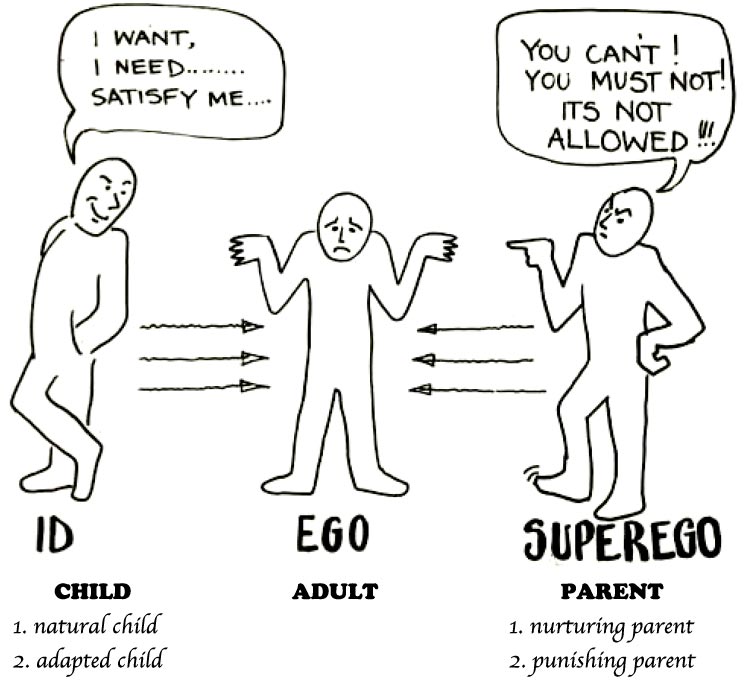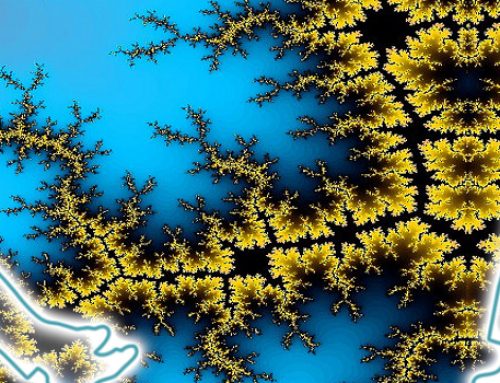A student submitted this cartoon - here is my response: Nice graphic - did you draw it, or is it copied from somewhere?
Some suggestions for clarification: I think the face of the Id looks more like a cynical, demanding parent than a demanding, passionate or even greedy child. The poor Ego looks adequately squeezed between the two (but sometimes, of course, it fancies itself as an 'in-control' super-hero, and not a besieged victim). And there are, of course, some problems in equating Freud’s model Id – Ego – Super-Ego with the Transactional Analysis model of child-adult-parent.
For a start, the point of the Super-Ego was that it is precisely not a nurturing parent, but a negative, critical, punishing parent. The TA model has an advantage in calling that part the ‘parent’ (which in many ways makes more sense), because then we can subdivide the parent into the 'good parent' and the 'bad parent', as the annotations suggest.
But that in turn raises the question: what is ‘good’ and what is ‘bad’?
Even the formulation ‘nurturing’ versus ‘punishing parent’ can be misleading: because some parents wound their child by being neglectful and absent, rather than punishing. So in order not to misleadingly restrict the definition of that parent part, it’s probably best to call it the ‘wounding parent’, or the ‘wounding object’ (to make clear that it is not precisely the outer parent, but the internal parental object as perceived by the child).
But if we re-translate the ‘punishing parent’ into the ‘wounding parent’ (which I think is a good idea because it’s more accurate and comprehensively generic), what is a good term for the ‘nurturing parent’, taking into account that some parents are ‘over-nurturing’?
In the most general terms, the child can get the wounded by the parent being too close, too invested, too invasive; or by the parent being too absent, neglectful, ignoring. Or maybe both at different times. Some children get hurt by the parent not allowing them to separate and individuate, being too invested in a continuing symbiosis with the child.
The other problem with the term ‘nurturing parent’ is that ideally we want to distinguish the ‘good-enough parent’ from the ‘idealised parent’ (which is the logical opposite, the antidote of the 'bad parent' - there is no need for the 'idealised' unless the 'bad' is always already present and taken for granted).
Modern child development research and theories do not imagine the good parent as being in continuous harmonious attachment with the child - on the contrary: they recognise that child development seems to have growth spurts when something goes wrong in the attachment: the bond ruptures, there is a crisis, and the child’s psyche grows if the rupture is interactively, intersubjectively repaired. Balint used to call the ideal state between child and parent the ‘harmoniously interpenetrating mix’. But modern developmental research suggests that development occurs in rupture-and-repair cycles. That is not quite the same idea as Winnicott’s term: the ‘good-enough parent’, but nevertheless: that term captures the normal mid-point between 'bad' and 'idealised' quite well.
The subdivision of the child into ‘natural’ (or 'free' as it's called in TA) and ‘adapted’ makes sense, as the two terms correspond neatly with the ‘good-enough’ and the ‘wounding parent’, except that we should subdivide the ‘adapted child’ into the ‘hurt’, the ‘angry’ and the ‘adapted’ child, as the three stages of how the child responds to being wounded.
I am using those terms in conjunction with the notion of 'character formation' derived from the Reichian tradition, which links these 'ego-states' (as they are called in TA) with bodymind processes and internal objects as bodymind processes. One of my ancient hand-outs links 'character formation' with TA language.



Leave A Comment
You must be logged in to post a comment.